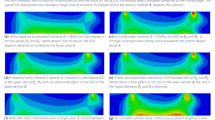Abstract
Animal caretakers working in NHP areas must wear facial PPE to protect themselves from the zoonotic hazards related to splash exposures, but PPE that is uncomfortable may present its own risks. The authors evaluated the level of protection offered by several types of facial PPE against a variety of simulated facial mucocutaneous exposures of the sort that could occur during typical procedures in Old World NHP facilities and determined that less restrictive PPE can be used without compromising safety.
This is a preview of subscription content, access via your institution
Access options
Subscribe to this journal
We are sorry, but there is no personal subscription option available for your country.
Buy this article
- Purchase on Springer Link
- Instant access to full article PDF
Prices may be subject to local taxes which are calculated during checkout





Similar content being viewed by others
References
Dooly, C.R., Johnson, A.T. & Brown, E.Y. Performance decrement due to altered vision while wearing a respiratory face mask. Mil. Med. 159(5), 408–411 (1994).
Garner, A., Laurence, H. & Lee, A. Practicality of performing medical procedures in chemical protective ensembles. Emerg. Med. Australas. 16(2), 108–113 (2004).
Institute for Laboratory Animal Research, National Research Council. Occupational Health and Safety in the Care and Use of Nonhuman Primates 24, 78, 88, 100–102 (National Academies Press, New York, 2003).
Institute for Laboratory Animal Research, National Research Council. Occupational Health and Safety in the Care and Use of Research Animals 114 (National Academies Press, New York, 1997).
Centers for Disease Control. Biosafety in Microbiological and Biomedical Laboratories (BMBL) 4th edn. (US Government Printing Office, Washington, DC, 1999).
Centers for Disease Control. Guidelines for prevention of Herpesvirus simiae (B virus) infection in monkey handlers. Morb. Mort. Week. Rep. 36(41), 680–682, 687–689 (1987).
Cohen, J.I. et al. Recommendations for prevention of and therapy for exposure to B virus (Cercopithecine Herpesvirus I). Clin. Infect. Dis. 35(10), 1191–1203 (2002).
Occupational Safety & Health Administration. General description and discussion of the levels of protection and protective gear. 29 CFR 1910.120 App. B.
Occupational Safety & Health Administration. Eye and face protection eTool, PPE Selection. (2004). http://www.osha.gov/SLTC/etools/eyeandface/ppe/.
Bolyard, E.A. et al. Guidelines for infection control in health care personnel, 1998. Infect. Control Hosp. Epidemiol. 19(6), 407–463 (1998).
Centers for Disease Control. Slideset: Guidance for the selection and use of personal protective equipment (PPE) in healthcare settings. (2004). http://www.cdc.gov/ncidod/hip/ppe/default.htm.
Tablan, O.C., Anderson, L.J., Besser, R.B., Bridges, C. & Hajjeh, R. Guidelines for preventing health care–associated pneumonia, 2003. Morb. Mort. Week. Rep. 53(RR03), 1–36 (2004).
TB Infection-Control Guidelines Work Group, Centers for Disease Control. Guidelines for preventing the transmission of Mycobacterium tuberculosis in health-care facilities, 1994. Morb. Mort. Week. Rep. 43(RR13), 1–132 (1994).
Nighswonger, T. Make sure workers know how to shield their faces from specific hazards. Occupational Hazards, Penton Media, Inc. (2002). http://www.occupationalhazards.com.
American National Standards Institute. Practice for occupational and educational eye and face protection standard Z87.1-1979.
Mitchell, N.J. & Hunt, S. Surgical face masks in modern operating rooms—a costly and unnecessary ritual? J. Hosp. Infect. 18(3), 239–242 (1991).
Chen, S.K., Vesley, D., Brosseau, L.M. & Vincent, J.H. Evaluation of single-use masks and respirators for protection of health care workers against mycobacterial aerosols. Am. J. Infect. Control 22(2), 65–74 (1994).
Hodous, T.K. & Coffey, C.C. The role of respiratory protective devices in the control of tuberculosis. Occup. Med. 9(4), 631–657 (1994).
McCluskey, F. Does wearing a face mask reduce bacterial wound infection? A literature review. Br. J. Theatre Nurs. 6(5), 18–20 (1996).
Belkin, N.L. The evolution of the surgical mask: filtering efficiency versus effectiveness. Infect. Control Hosp. Epidemiol. 18(1), 49–57 (1997).
Romney, M.G. Surgical face masks in the operating theatre: re-examining the evidence. J. Hosp. Infect. 47(4), 251–256 (2001).
Rawson, D. The basics of surgical mask selection. Infect. Control Today (2003). http://www.infectioncontroltoday.com/articles/331feat2.html.
Lipp, A. The effectiveness of surgical face masks: what the literature shows. Nurs. Times 99(39), 22–24 (2003).
Miller, R.L., Micik, R.E., Abel, C. & Ryge, G. Studies on dental aerobiology. II. Microbial splatter discharged from the oral cavity of dental patients. J. Dent. Res. 50(3), 621–625 (1971).
Pigman, E.C., Karch, D.B. & Scott, J.L. Splatter during jet irrigation cleansing of a wound model: a comparison of three inexpensive devices. Ann. Emerg. Med. 22(10), 1563–1567 (1993).
Jain, K., Simoni, E.J. & Munn, J.S. Improvement in suction catheter efficiency and safety in arterial operations. Cardiovasc. Surg. 3(4), 431–435 (1995).
Mohandas, K.M. & Gopalakrishnan, G. Mucocutaneous exposure to body fluids during digestive endoscopy: the need for universal precautions. Indian J. Gastroenterol. 18(3), 109–111 (1999).
Cox, A.J., Cook, T.A. & Wang, T.D. Decreased splatter in dermabrasion. Arch. Facial Plast. Surg. 21(1), 23–26 (2000).
Friberg, B., Friberg, S., Ostensson, R. & Burman, L.G. Surgical area contamination—comparable bacterial counts using disposable head and mask and helmet aspirator system, but dramatic increase upon omission of head-gear: an experimental study in horizontal laminar air-flow. J. Hosp. Infect. 47(2), 110–115 (2001).
Carrington, P.R. The surgical looking glass: a readily available safeguard against eye splash injury/contamination during infiltration of anesthesia for cysts and other “porous” lesions of the skin. Dermatol. Surg. 28(4), 356–358 (2002).
Sharma, J.B., Gupta, A., Malhotra, M. & Arora, R. Facial and body blood contamination in major gynecologic surgeries. J. Obstet. Gynaecol. Res. 29(6), 402–405 (2003).
Author information
Authors and Affiliations
Corresponding author
Ethics declarations
Competing interests
The authors declare no competing financial interests.
Rights and permissions
About this article
Cite this article
Cooper, D., Charles, D., Durnell, A. et al. Assessment of personal protective equipment used for facial mucocutaneous exposure protection in nonhuman primate areas. Lab Anim 34, 49–53 (2005). https://doi.org/10.1038/laban0505-49
Received:
Accepted:
Issue Date:
DOI: https://doi.org/10.1038/laban0505-49


